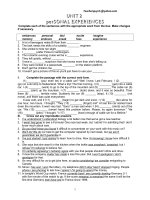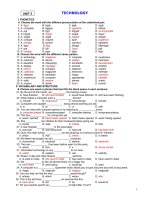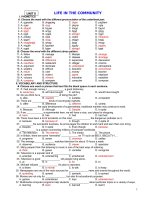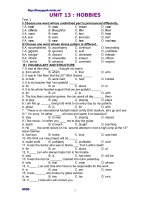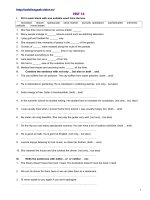TEST OF UNIT 14- WITH KEY
Bạn đang xem bản rút gọn của tài liệu. Xem và tải ngay bản đầy đủ của tài liệu tại đây (116.72 KB, 10 trang )
TEST OF UNIT 14
I. Mark the letter A, B, C or D to indicate the word whose
underlined part is pronounced differently from that of the rest in
each of the following questions:
1. A. symbol B. emergency C. poverty D.
qualify
2. A. appalled B. dedicated C. designed D.
injured
3. A. society B. delegate C. president D.
protection
II. Mark the letter A, B, C or D to indicate the word that differs
from the rest in the position of main stress in each of the following
questions:
4. A. colleague B. appall C. devote D.
victim
5. A. suffering B. president C. protection
D. conference
III. Mark the correct option A, B,C or D to fill each of the
following blanks :
6. All payments to the ICRC are_______ and are received as
donations.
A. volunteer B. voluntary C. voluntarily
D. volunteered
7. One of the tasks of the Red Cross is also to support local ____
care projects.
A. health B. healthy C. healthful D.
healthily
8. The international Red Cross has about 97 million volunteers
whose main ______is to protect human life and health.
A. mission B. experience C. organization D.
rule
9. The international Red Cross helps people in need without any
discrimination based on ____, race, religion, class or political
opinions.
A. national B. nationally C. nationality
D. native
10. The AIDS ____ continues to spread around the word. Up to
4,000 people are infected with the HIV virus every single day.
A. treatment B. epidemic C. tsunami
D. damage
11. In times of war, the Red Cross is dedicated to reducing the
sufferings of wounded soldiers, civilians and prisoners of war.
A. mounted B. excited C. devoted D.
interested
12. During the flood, Army helicopters came and tried to
evacuate___ injured.
A. a B. an C. the D. Ø
13. Go____ this book because it has the information you need.
A. over B. by C. off D. on
14. The passengers had to wait because the plane___ off one hour
late.
A. took B. turned C. cut D. made
15. Be careful! The tree is going to fall.
A. Look out B. Look up C. Look on D.
Look after
16. They decided to postpone their journey till the end of the month
because of the epidemic.
A. take up B. turn round C. put off d
do with
17. Frankly speaking, your daughter does not take___ you at all.
A. after B. along C. up D. over
18. She is not really friendly. She does not get on well _____ her
classmates.
A. from B. with C. for D. to
19. I would be grateful if you kept the news _____ yourself. Do not
tell anyone about it.
A. from B. to C. for D. at
20. I do not use those things any more. You can _____them away.
A. get B. fall C. throw
D. make
21. They were late for work because their car _____ down.
A. got B. put C. cut
D. broke
22. It took me a very long time to recover from the shock of her
death.
A. turn off B. take on C. get over D. keep
up with
23. Boy! _____away your toys and go to bed right now.
A. Come B. Lie C. Put
D. Sit
24. The music is too loud. Could you turn ______ the volume,
please?
A. down B. up C. round D. on
25. The Red Cross gives medical aid and other help to victims of
major disasters such as floods, earthquakes, epidemics, and famines.
A. shortage of water B. serious droughts
C. serious shortage of food D. poverty
26. - Could you bring me some water? - _____________.
A. I don’t want to B. Certainly, sir
C. Yes, I can D. No, I can’t
27. - How do you do? - ___________ .
A. I’m well. Thank you B. Ok
C. Not too bad D. How do you do?
28. Thank you for the nice gift. - ___________ .
A. But do you know how much it costs? B. The same to you.
C. In fact, I myself don’t like it D. I’m glad you like
it.
29. - Would you like something to eat?
- ____________ I’m not hungry now.
A. Yes, it is B. Yes, I would C. No, no problem
D. No, thanks
30. - Would you like anything else? “___________”.
A. That’s all. Thank you B. Yes, I like
everything
C. Two, please D. Yes, I would
IV. Mark the letter A, B, C or D to show the underlined part that
needs correction:
31. Among many other program, UNICEF also supports the
international Child Rights
A B C D
Information Network.
32. They decided to turn off their journey till the end of the month
because of the epidemic. A B
C D
33. The World Health Organization was established in 7 April 1948.
A B C D
34. Remember to take over your shoes when you are in a Japanese
house.
A B C D
35. Many people are dying by various types of cancer.
A B C D
V. Mark the letter A, B, C or D to indicate the sentence which is
closest in meaning to the given one.
36. You can look up this word in the dictionary.
A. There are a lot of words in the dictionary for you to look at.
B. You can find the meaning of this word in the dictionary.
C. The dictionary contains a lot of words except the one you
need.
D. You should buy this dictionary to find the word you need.
37. Do you have a good relationship with your neighbours?
A. Are you getting with your neighbours?
B. Are you going along with your neighbours?
C. Are you getting well with your neighbours?
D. Are you getting along with your neighbours?
38. After she had finished her homework, she watched television.
A. Had she finished her homework she would have watched
television.
B. As soon as she finished her homework she would have
watched television.
C. Before she had watch television she finished her
homework.
D. She had finished her homework before she watched
television.
39. People say that the price of gold is going up.
A. The price of gold is said going up
B. It was said that the price of gold is going up
C. The price of gold is said to going up
D. The price of gold is said to be going up.
40. The bridge was so low that the lorry couldn’t go under it.
A. It was so low bridge that the lorry couldn’t go under it.
B. The bridge wasn’t high enough for the lorry to go under it.
C. It was such low bridge that the lorry couldn’t go under it.
D. The bridge was too low for the lorry to go under.
VII. Read the following passage and mark the letter A, B, C or D
to indicate the correct answer to each of the questions from 41 to
45:
The World Health Organization (WHO) is a specialized agency
of the United Nations that acts as a coordinating authority on
international public health. Established on 7 April, 1948, and
headquartered in Geneva, Switzerland, the agency inherited the
mandate and resources of its predecessor, the Health Organization.
The WHO's constitution, states that its objective is "the
attainment by all peoples of the highest possible level of health." Its
major task is to combat diseases, especially key infectious diseases,
and to promote the general health of the people of the world. The
WHO also sponsors programs to prevent and treat serious epidemics
such as SARS, malaria, and AIDS. The WHO supports the
development and distribution of safe and effective vaccines,
pharmaceutical diagnostics, and drugs. After over 2 decades of
fighting smallpox, the WHO declared in 1980 that the disease had
been eradicated - the first disease in history to be eliminated by
human effort.
The WHO is nearing success in developing vaccines against
malaria and aims to eradicate polio within the next few years. The
organization has already endorsed the world's first official
HIV/AIDS Tool kit for Zimbabwe making it an international
standard. In addition to its work in eradicating disease, the WHO
also carries out various health-related campaigns, for example, to
boost the consumption of fruits and vegetables worldwide and to
discourage tobacco use.
Experts met at the WHO headquarters in Geneva in February,
2007, and reported that their work on pandemic influenza vaccine
development had achieved encouraging progress. More than 40
clinic trials have been completed or are ongoing. Most have focused
on healthy adults. Some companies, after completing safety analyses
in adults, have initiated clinical trials in the elderly and in children.
All vaccines so far appear to be safe arid well-tolerated in all age
groups tested.
41. The World Health Organization (WHO) _______.
A. works on international public health B. has no relation to
the United Nations
C. only takes care of Swiss people D. has no
predecessor
42. Which is not mentioned in the second paragraph 'as the tasks of
the World Health Organization?
A. to promote the general health of everyone in the world
B. to support pharmaceutical diagnostics, and drugs
C. To combat diseases
D. To supply food for patients.
43. According to the text, which disease has been eradicated?
A. Malaria B. AIDS C. SARS D.
Smallpox
44. According to the third paragraph, the World Health Organization
______.
A. has not developed vaccines against malaria yet.
B. doesn’t try to eradicate polio.
C. is not concerned about polio.
D. doesn’t carry out various health-related campaigns.
45. Influenza vaccine _______.
A. has only been used for adults
B. cannot be used for children
C. has appeared to be safe in all age groups tested
D. causes bad effects on children and elderly people
VIII. Read the following passage and mark the letter A, B, C, or D
to indicate the correct word for each of the blanks from 46 to 50:
UNICEF (The United Nations Children’s Fund) is mandated by
the United Nations General Assembly to advocate for the (46) _____
of children's rights, to help meet their basic needs and to expand
their opportunities to reach their full potential. UNICEF is guided by
the Convention on the Rights of the Child and tries to establish
children's rights as enduring ethical principles and international
standards of (47) _____ towards children. UNICEF (48) _____ that
the survival, protection and development of children are universal
development. UNICEF mobilizes political will and material (49)
_____ to help countries, particularly developing countries, ensure a
"first call for children" and to, build their capacity to form
appropriate policies and (50) _____ services for children and their
families.
46. A. protest B. destruction C. protection D.
achievement
47. A. poverty B. behavior C. medicine
D. injure
48. A. insists B. devotes C. treats D.
mounts
49. A. sources B. mines C. budgets D. funds
50. A. care B. appeal C. supply D. react
KEY TO TEST OF UNIT 14
1.D 2.B 3.A 4.D 5.C 6.B 7.A 8.A 9.C 10.B
11.C 12.C 13.A 14.A 15.A 16.C 17.A 18.B 19.B 20.C
21.D 22.C 23.C 24.A 25.C 26.B 27.D 28.D 29.D 30.A
31.B 32.A 33.D 34.B 35.C 36.B 37.D 38.D 39.D 40.D
41.A 42.D 43.D 44.A 45.C 46.C 47.B 48.A 49.A 50.C




